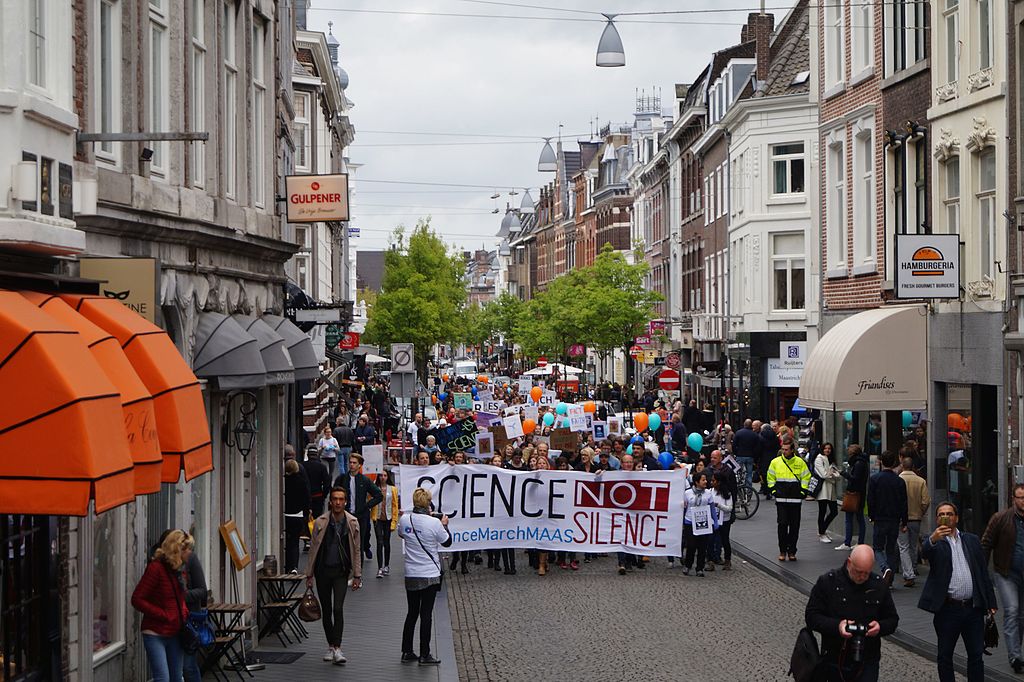On the evening of Easter Sunday, 74-year-old Pennsylvania resident Robert Godwin was enjoying a walk through his neighborhood after a holiday meal with his family when he was approached, at random, by self-described “monster” Steve Stephens. Stephens, who was given the moniker “The Facebook Killer” by the media, blamed what was about to happen to Godwin on his broken relationship with his girlfriend, before shooting Godwin in the head, killing him instantly.
The Artificial Intelligence of Google’s AlphaGo
Last week, Google’s AlphaGo program beat Ke Jie, the Go world champion. The victory is a significant one, due to the special difficulties of developing an algorithm that can tackle the ancient Chinese game. It differs significantly from the feat of DeepBlue, the computer that beat then-chess world champion Garry Kasparov in 1997, largely by brute force calculations of the possible moves on the 8×8 board. The possible moves in Go far eclipse those of chess, and for decades most researchers didn’t consider it possible for a computer to defeat a champion-level Go player, because designing a computer with such complexity would amount to such great leaps towards creative intuition on the computer’s part.
Continue reading “The Artificial Intelligence of Google’s AlphaGo”
The Fire Beneath Our Feet
Centralia, Pennsylvania has been burning since 1962. Or rather, the ground beneath the town is burning: an underground coal seam fire that caused the town to be mostly abandoned has been burning for over 50 years, and will continue for at least another 250. The fire likely began when a trash fire ignited the coal seam in the network of old mines beneath the town. Gradually, a slow apocalypse took place: snow couldn’t always stick to the heated ground, vegetables could grow year-round, the main highway sunk eight feet, and residents began to pass out from carbon monoxide gas issuing from their basements. By 1991, the town was almost entirely government-owned under eminent domain, and in 2002 the ZIP code was revoked. The few residents that remain do so at their own risk.
The Handmaid’s Tale and Commodifying Reproduction
The Handmaid’s Tale by Margaret Atwood has experienced a resurgence in popularity recently, not only because of its inherent relevance to today’s society, but also because of the positive critical reception of the mini-series on Hulu.
Continue reading “The Handmaid’s Tale and Commodifying Reproduction”
Moral Panic and the “Blue Whale Game”
Over the last few months, there have been reports of a deadly internet game, “The Blue Whale.” Allegedly, teenage gamers participate by following the instructions provided by the designers of the game. These instructions include watching horror films and waking up in the middle of the night. The challenge goes on for 50 days, and then, the final instruction is to commit suicide.
Harm Reduction, Moral Relativism, and Female Genital Mutilation
In a first-of-its-kind legal case, Dr. Jumana Nagarwala is being prosecuted in Detroit, Michigan for violating a 1996 federal law against female genital mutilation. Nagarwala was indicted alongside another woman who was allegedly present in the room during the mutilation. Nagarwala’s husband, who owns the clinic where the procedure occurred, is also being prosecuted. Nagarwala is accused of performing female genital mutilation on two seven-year-old girls who had been brought from Minnesota for the procedure.
Continue reading “Harm Reduction, Moral Relativism, and Female Genital Mutilation”
Alcohol Legislation in Utah: Drunk with Power?
The United States has long struggled with a set of deeply divided attitudes toward alcohol. To be sure, alcohol can be quite dangerous, so it is certainly reasonable to be cautious and concerned about its use in certain contexts. On the other hand, one of the clear lessons taught by our experiment with Prohibition is that individuals feel that restrictive alcohol policies constitute unwarranted violations of their autonomy.
Continue reading “Alcohol Legislation in Utah: Drunk with Power?”
A Controversy around the Cheerleading Industry
It is not uncommon to see cheerleaders at every professional sports game. They usually comprise young, mostly white women who have a profession outside their cheerleading careers. A game pamphlet typically has information about the team’s cheerleaders – not only their names and pictures, but also their occupation and age are made public.
Continue reading “A Controversy around the Cheerleading Industry”
They’re Baaack: Volkswagen and Environmental Responsibility
It seemed as though the world had seen the end of Volkswagen after a massive scandal was uncovered by the Environmental Protection Agency (EPA) back in September 2015. One of VW’s major marketing campaigns in the United States was flaunting their diesel cars’ low emissions. It turns out, in fact, that they had been cheating on emissions tests for years by installing software in their cars to detect when an emissions test was being run. At least 482,000 cars were discovered with this “defeat device” in the United States, and the German car maker admitted to producing 11 million cars worldwide with this device as well. The crisis has even been termed “Dieselgate” by some. With society’s trend towards environmental consciousness, many were unsure how VW would recover from this.
Continue reading “They’re Baaack: Volkswagen and Environmental Responsibility”
A Clash of Cultures Atop New Zealand’s Mount Taranaki
A New Zealand Playboy model and popular Instagrammer is in hot water for offending her own country earlier this month. 25-year-old Jaylene Cook recently posted a controversial picture on her personal Instagram page, capturing her in a precarious position: standing nude atop New Zealand’s Mount Taranaki. While many of her Instagram followers seemed to enjoy her picture, locals did not.
Continue reading “A Clash of Cultures Atop New Zealand’s Mount Taranaki”
Why Trumpcare Hurts Women’s Health
Last week, the House of Representatives passed the American Health Care Act 217-213, which will effectively repeal the Affordable Care Act (Obamacare) if the bill makes it to President Trump’s desk. The bill, nicknamed Trumpcare, was passed without a score from the Congressional Budget Office (CBO), meaning that the true costs of the bill remain uncertain. Estimates from the New York Times based on the CBO score for an earlier version show that the bill will cause around 24 million Americans to lose healthcare. The bill has been amended since the earlier version, which was pulled after only 17 percent of Americans supported the bill, but much of the bill remains that same as the one that lacked support.
Drug Addiction: Criminal Behavior or Public Health Crisis?
It is painfully obvious that the United States is in the midst of an epidemic of opioid abuse. According to the US Department of Health and Human Services (DHHS), more people died from drug overdoses in 2014 than any other recorded year, and the majority of those overdose deaths involved opioids. DHHS and the Centers for Disease Control (CDC) claim that an increase in the prescription of pain medication is a primary driver of the opioid epidemic. According to the CDC, the amount of prescription opioids sold in the US has nearly quadrupled since 1999. However, Americans do not report higher levels of pain than they did in 1999.
Continue reading “Drug Addiction: Criminal Behavior or Public Health Crisis?”
In San Diego, Fighting Islamophobia in the Elementary School
In order to combat the “pervasive and underreported” bullying of Muslim children in public schools, the San Diego public school district’s board has launched a campaign to fight Islamophobia. As one of the largest public school districts in the country, San Diego has set an important precedent for other districts. For this reason, the decision, voted 4-0 on April 4, has received both praise and backlash on social media.
Continue reading “In San Diego, Fighting Islamophobia in the Elementary School”
A Trump-Themed People’s Climate March
On a day that ironically, or appropriately, broke temperature records, over 200,000 people flocked to the nation’s capital to participate in The People’s Climate March. The march date coincided with President Trump’s 100th day in office, often considered a landmark in every presidency. However, President Trump was not present to observe the massive demonstration, but instead held rallies in support of his presidency in Harrisburg, Pennsylvania. Regardless of Trump, the People’s Climate March aimed to send a bigger message about the importance of environmental protection and climate action. However, like any large protest, the motivations and perspectives of individuals participating differed.
Doxxing for Social Justice
In 2015, after Lindsey Graham said that Donald Trump should “stop being a jackass,” Trump read Graham’s personal cell phone number aloud to a crowd at one of his campaign rallies and urged people to call the number. Journalists who dialed the number were directed to an automated voicemail account reporting “Lindsey Graham is not available.” His voicemail inbox was, unsurprisingly, full.
Evaluating Solitary Confinement: A Matter of Values
Untidiness, tattooing, insolence towards a staff member, “reckless eyeballing,” and possession of an excessive quantity of postage stamps. These are all behaviors that are officially punishable by “restriction to quarters” and “change of housing” in the US Federal Prison System, according to Quartz. Thus, you can be placed in solitary confinement for relatively innocuous infractions, and the clear potential for abuse of this practice is one reason why the use of solitary confinement to punish prisoners has recently come under intense pressure. New York reached a legal settlement in 2015 with the New York Civil Liberties Union regarding the aggressive use of solitary confinement in its prisons, and a multi-year process was begun to lessen the times people spent in solitary confinement and to improve conditions in solitary confinement units.
Continue reading “Evaluating Solitary Confinement: A Matter of Values”
Homeless in Utah, Desperately Seeking a Backyard
This article has a set of discussion questions tailored for classroom use. Click here to download them. To see a full list of articles with discussion questions and other resources, visit our “Educational Resources” page.
For more than 60 years, the sprawling Utah State Prison sat nestled at the base of the Wasatch Mountain range in Draper, Utah. The prison was home to such notorious inmates as serial killers Ted Bundy and Gary Gilmore, and serial pedophile and cult leader Warren Jeffs. Utah was the first state to reinstitute the death penalty after the Supreme Court’s moratorium ended in 1973, and the state has since executed 51 people. In 2015, the Utah legislature made the decision to relocate the prison to West Salt Lake City. In its place, Draper Mayor Troy Walker proposed to house something that, as it turns out, struck Draper citizens as far more distasteful than even the prison—a shelter for the homeless.
The proposal was part of a plan to disperse the burgeoning 1,100-resident caseload of the The Road Home, a homeless shelter located in Salt Lake City. Walker’s specific proposal was for Draper to take on the responsibility of a subsection of that population—a group of women actively looking for work, and their dependent children. Explaining his decision to throw Draper’s name into the ring for the site of the new shelter, Walker said, “It’s the right thing to do; it’s the Christian thing to do. It’s the thing that will set us apart and make us the kind of people we are.”
Dutiful to his constituency, Walker held a town hall meeting on the topic at a local middle school. Nearly 1,000 people attended. Some of them packed the halls outside of the auditorium to avoid fire code violations. Video of the meeting that ensued quickly went viral on the Internet. Attendees of the meeting were overwhelmingly opposed to the relocation of the homeless shelter in their town. At one, point, a homeless man stood up to testify to his experience with how homeless shelters benefit their charges. He was booed into silence.
Many watching the situation closely are concerned by the gentrification that they are seeing. The Salt Lake bedroom community of Draper is becoming more and more upscale. Property on the base of the mountain is prime real estate. The new site of the prison is near the Salt Lake International Airport and Rose Park, one of the least affluent communities in the area. Already home to a number of halfway houses, rehab centers, and a parole violator center, Rose Park can expect a new prison instead of the remodeled fairgrounds that they were promised. The refusal of the homeless shelter seems to be motivated by similar considerations. The “not in my backyard!” mentality seems to entail either a desire for institutions like prisons and homeless shelters to not exist at all, or for their location to be in other, poorer, backyards.
Many moral theories emphasize the value of universalizability. The idea is that, if you want to ensure that your decision is a moral one, it has to be a decision that you wouldn’t mind if someone else made under circumstances that were sufficiently similar. If we want to bar homeless shelters from our own communities, we must be comfortable with everyone else barring homeless shelters from their communities as well. Of course, we can’t do that unless we simply want homeless shelters to no longer exist. After all, every community is someone’s community.
Of course, the concerns of the citizens of Draper are not entirely baseless. Homeless shelters are not good for property values. Though we don’t want to confuse correlation with causation, it is true that property values are 12.7 percent lower in areas with homeless shelters than they are in other areas (all other things being equal). Homeowners have obligations to provide for themselves and their families. Their ability to do this may be compromised if they lose equity in their homes.
Homeowners also have a legitimate interest in their own safety, and the safety of their families. Mental illness is common among the homeless population, and so is drug and alcohol abuse. Residents of the area may have justifiable concerns that their communities will be less stable if the homeless population is introduced.
It is worth pointing out, however, that less affluent families living in lower-income communities have the same safety and stability fears as the Draper residents. If the concerns of the Draper residents are justified, and if those concerns are sufficient for the Mayor of Draper to withdraw his offer of the prison as a location for the needs of the state’s homeless, why aren’t the identical concerns of those living in less affluent communities deserving of equal consideration?
Let’s not forget the plight of the homeless population. Many moral philosophers have suggested that the best measure of the morality of a society is the way the least advantaged members of that society are treated. Booing a homeless person into silence at a town hall meeting doesn’t say anything good about the society in which that kind of thing happens.
There is a silver lining to this cloud, however. Though this particular situation suggests that there is room for some serious character development on the part of many Utah citizens, Utah has been making international news in a more positive way for a different approach to homelessness. Implementing a novel new approach called “Housing First,” Utah has reduced homelessness by 72 percent over nine years. The idea behind this approach is to do what the name suggests—provide housing to homeless people right away, without making that housing contingent on mental health or sobriety. When dealt with in this way, 88 percent of the homeless population remains in the housing a year later, at a cost to the state less than it incurred when the homeless people were on the street.
The success of the Housing First program suggests a need to change our collective mindset toward the homeless, and perhaps about access to crucial human goods and services as well. It makes sense, not just from a legal perspective, but also from a moral perspective, to attend to the basic needs of all human beings, especially those that are much less fortunate than the rest of us.
Abortion and the Artificial Womb
This past week, scientists have shared that they have created the most successful artificial womb yet. Lambs have been born healthily after spending up to half of their gestation in a simulated uterus.
For now, this technology is proving to be intriguingly successful in lambs. To keep hormones, temperature, oxygen, and other life-sustaining factors stable for humans will be quite a hurdle, but scientists and spectators are already hypothesizing about what this could mean farther down the line (specialists estimate testing this technology on humans would be about three years in the future). Artificial wombs could be of help not just with premature births on the cusp of viability, but perhaps even earlier. Perhaps, artificial wombs can be of use soon after conception, or are the next stage of development for so-called test tube babies. In that case, we could develop children without the need of a woman’s uterus altogether!
Law Enforcement Surveillance and the Protection of Civil Liberties
In a sting operation conducted by the FBI in 2015, over 8,000 IP addresses in 120 countries were collected in an effort to take down the website Playpen and its users. Playpen was a communal website that operates on the Dark Web through the Tor browser. Essentially, the site was used to collect images related to child pornography and extreme child abuse. At its peak, Playpen had a community of around 215,000 members and more than 117,000 posts, with 11,000 unique visitors a week.
Continue reading “Law Enforcement Surveillance and the Protection of Civil Liberties”
Justice on a Conveyor Belt: The Death Penalty in Arkansas
In March and April of this year, the state of Arkansas made national headlines for its plan to execute eight prisoners over the course of 11 days. The speed involved is striking, especially when compared with national annual execution averages; only 20 people were executed nationwide in 2016.
The truth is, Arkansas is racing against the clock. Like most states, the primary method of execution in Arkansas is lethal injection. Death by lethal injection is typically accomplished using a three-drug cocktail. In Arkansas, midazolam is used as an anesthetic, ideally ensuring that the prisoner does not experience any pain. Vecuronium bromide is used to cause paralysis before potassium chloride is used to stop the heart. The trouble is, the remaining midazolam that Arkansas possesses is about to reach its expiration date, and it looks like they won’t have access to more any time soon.
Continue reading “Justice on a Conveyor Belt: The Death Penalty in Arkansas”
A March for Science, or for Something Else?
A worldwide march in favor of science was successfully carried out on April 22. It was convoked by a wide range of groups, to be held on Earth Day. The initiative came out as a result of major concerns over President Donald Trump’s policies, which include the disbanding of the Environmental Protection Agency, budget cuts in scientific research, and the elimination of scientists’ roles as advisors in the government.
The march was allegedly non-partisan. But, there are plenty of reasons to think otherwise. Critics of the march have seen it as leftist ideology masquerading as legitimate scientific activity. If, indeed, the march is more about politics and less about science, then that should be of concern to the scientific community.
Make no mistake: President Trump is no friend of science. His populist style appeals to unverified claims (or, as it is now called, “post-truth”), the very antithesis of any scientific procedure. His strongest base of supporters is made up of climate change deniers, creationists and anti-intellectualists who see no significance in scientific activity.
These people, however, need to be brought to the light of science. Some of these people may initially understand the importance of scientific activity, but ultimately become disappointed with scientists, because they seem them as too far to the left. They do have a point. To some extent, science has been hijacked by leftist ideology. If the scientific establishment wants to regain the trust of ordinary folks, then it must do a better job of purging its ideological bias.
Take, for instance, the choice of the day for the march. It was celebrated on Earth Day, an obvious appeal to the importance of discussions on climate change. No serious scientist would disagree that, indeed, global warming is a problem. But, what must be done about it is much more open to discussion. Scientists such as Matt Ridley and Bjorn Lomborg have long acknowledged that global warming is a problem, but at the same time, reasonably argue that short-term initiatives on carbon emission reduction (such the Paris Agreement) are far more harmful for the welfare of humanity. Fossil fuels do contribute to global warming, but they save lots of lives, especially in the developing world.
Sure, something must be done, but reducing economic growth, for the time being, is not a rational solution. A more reasonable alternative, as Lomborg has long proposed, is to invest in research in order to find more efficient ways of developing clean energy without reducing economic growth. Solar panels are not enough. The prospect of nuclear power is much more promising in this regard. Yet, for some strange reason, most ecological groups oppose it, and the scientific establishment does not seem to care. This plays into the right-wing narrative that so-called “science” is more about ideology than about facts.
Unfortunately, the overwhelming majority of people who went to the march in favor of science have a stand that goes far beyond the mere scientific facts on global warming. They make the unwarranted leap from scientific facts to a defense of leftist environmental policy. This is no way to bring Trump’s supporters to the light of science.
Global warming is not the only area where leftist ideology masquerades as science. Take evolutionary theory. Sure, Bible-quoting Creationists feel more at home at a Trump rally than at a scientific lecture on some college campus. And, of course, it is easy to mock people who believe the world is only 6,000 years old and want intelligent design to be taught in public schools. But, unfortunately, the scientific establishment fails to oppose other types of Creationists, the so-called “Creationists of the Mind” (the term was created by scientist Robert Kurzban). This brand of Creationists is made up of leftists who, for some strange reason, believe that Darwinism applies to the body, but not to the mind. They oppose evolutionary psychology on the grounds that it is racist, sexist and an intellectual tool to justify capitalism’s status quo. These Creationists of the Mind were the instigators of the firing of Larry Summers from the presidency of Harvard University, simply because he argued that in some areas of intellectual achievement, women are at a natural disadvantage (as evolutionary psychology claims). This bias in opposing one type of Creationism, but not the other, again plays into the right-wing narrative that the scientific establishment pays more attention to ideology than to facts.
Or, take GMOs. Humans have been genetically modifying organisms for at least 10,000 years. Now, thanks to impressive advances in genetics, we have the technology to do so even more efficiently. It is not hyperbole to claim that GMOs have the potential to solve the problem of world hunger once and for all. And yet, the scientific establishment is too timid to fully embrace GMO research and strongly refute those environmentalists who oppose these technologies (although it must be acknowledged that more than 100 Nobel laureates recently signed a letter defending GMOs).
The recent march in favor of science on Earth Day tried to build the narrative that anti-science is exclusively right-wing. That is clearly not the case. Alex Berezow and Hank Campbell make an extensive argument exposing the fallacies of the anti-scientific left, in their acclaimed book Science Left Behind. The scientific establishment should take note. Science is worth marching for. But, when that march becomes more of a ruse to propagate leftist ideology, it is ethically objectionable. Science needs all the support it can get, and it needs to persuade people to abandon their anti-scientific view of the world. But, when the scientific establishment is itself sequestered by some people who seem to care more about ideology than about facts, it fails in its attempt to bring the likes of Creationists and climate change deniers, to the light of science.





















